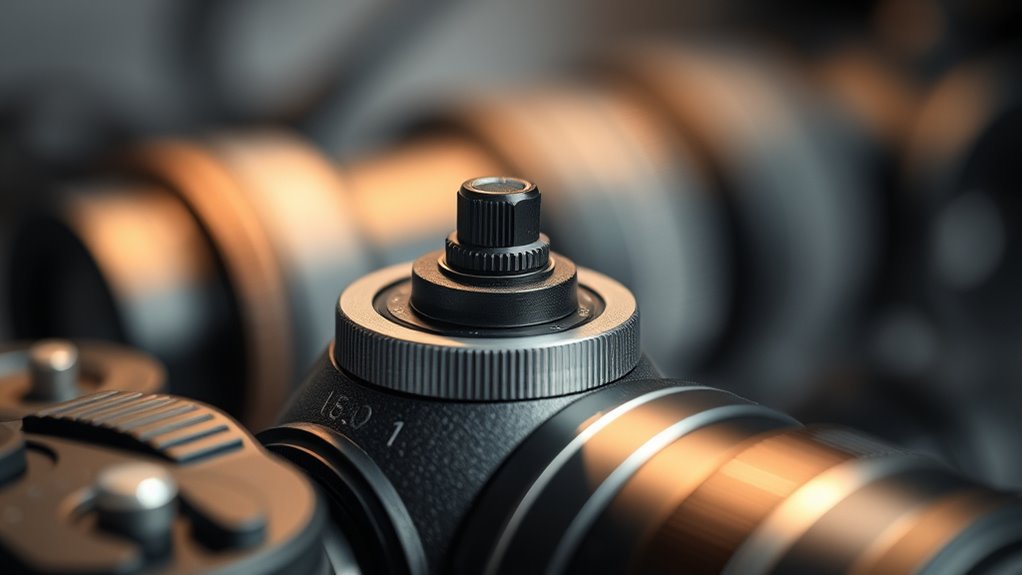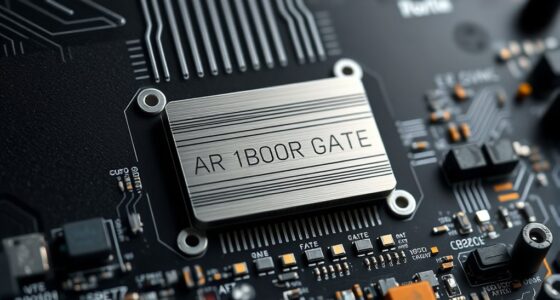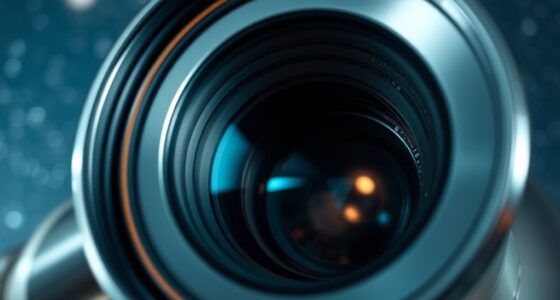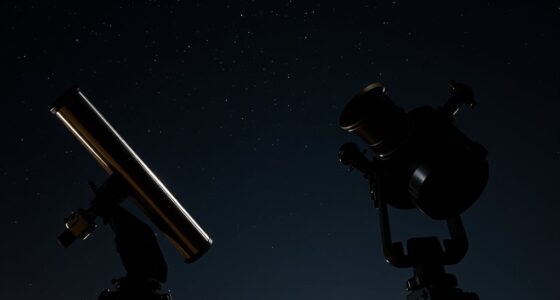Understanding backfocus is key to capturing sharp images, and spacers help you fine-tune your camera setup for perfect focus. If your photos are blurry or focus shifts, you might need to modify your backfocus with spacers and calibration tools. Proper techniques ensure consistent results, but avoid rushing or skipping steps. Keep these tips in mind; if you want to master focus accuracy, there’s more to discover just ahead.
Key Takeaways
- Proper backfocus alignment ensures sharp images; misalignment causes blurriness and focus inconsistencies.
- Spacers fine-tune the distance between lens and sensor, crucial during calibration and equipment upgrades.
- Use calibration tools like focus charts and masks for accurate, repeatable backfocus adjustments.
- Avoid shortcuts: ensure sensor alignment, clean lenses, and calibrate in good lighting to prevent focus errors.
- Select spacers based on material, thickness, and coatings; testing different options optimizes focus accuracy across scenarios.
What Is Backfocus and How Does It Affect Your Photos
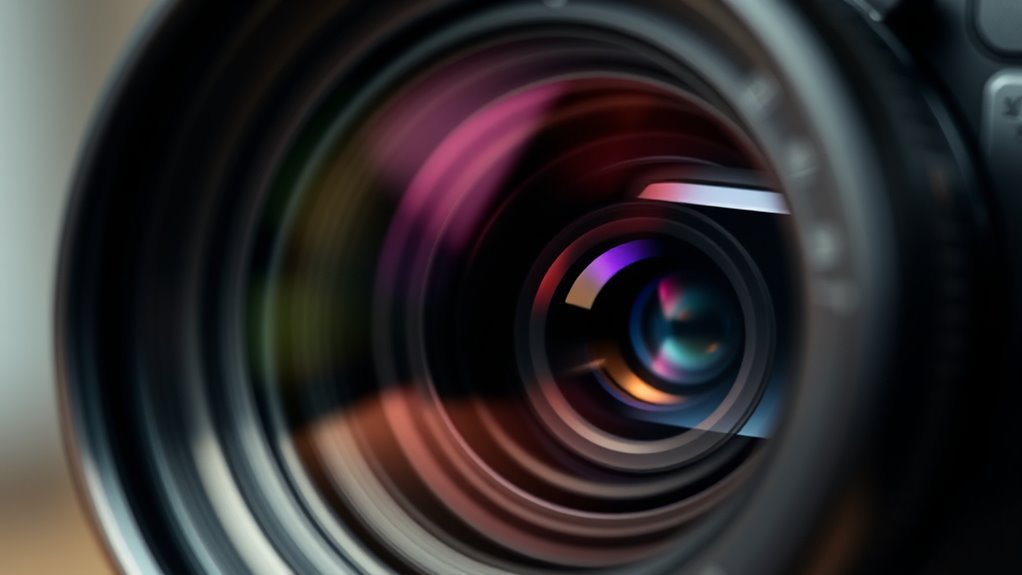
Backfocus refers to the distance between your camera’s lens and the sensor where the image is sharply focused. If this distance isn’t correct, your photos may appear blurry or have focus issues. The lens curvature plays a role here, as it influences how light converges onto the sensor. Proper sensor alignment ensures that the focal plane matches the lens’s focus point, preventing backfocus problems. When the sensor isn’t aligned correctly, even a well-calibrated lens can produce soft images or focus inconsistencies. Understanding backfocus helps you determine if your camera needs calibration or if there’s an issue with lens curvature or sensor alignment. Correctly managing backfocus is essential for achieving sharp, accurate photos, especially in professional or high-precision photography. Regular maintenance and understanding of sensor alignment can help prevent persistent backfocus issues.
The Role of Spacers in Camera and Lens Calibration
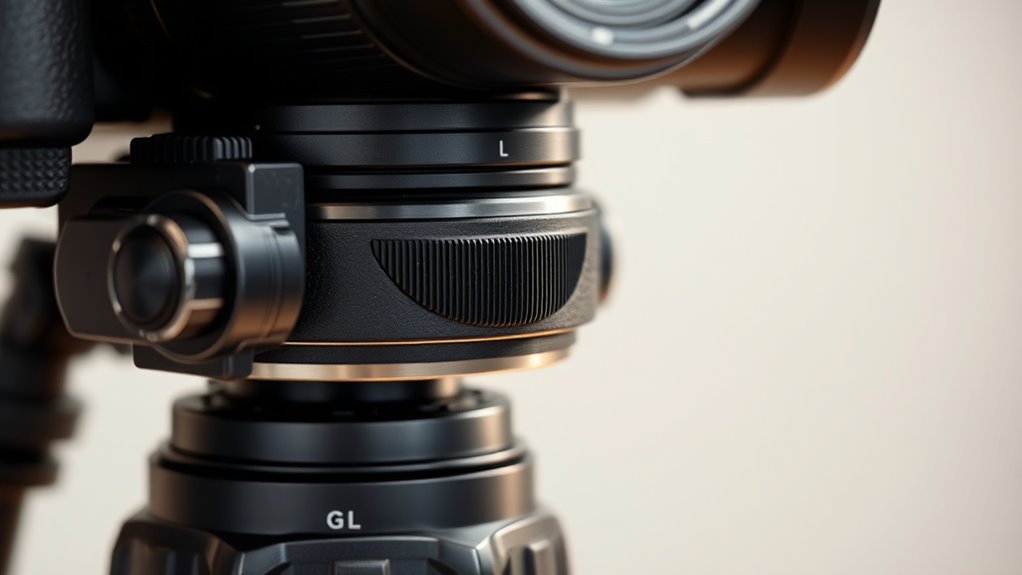
Spacers play a vital role in camera and lens calibration by helping fine-tune the distance between components to achieve perfect focus. They guarantee optimal sensor alignment, which is essential for sharp images. Proper spacer placement can compensate for lens inconsistencies or manufacturing variances, reducing backfocus issues. When adjusting spacers, consider how lens coatings might affect light transmission and focus performance. Precise spacing helps maintain consistent focus across different focal lengths and apertures. By controlling the gap between lens elements and the sensor, spacers help you achieve accurate autofocus results. This fine-tuning process is especially important when upgrading lenses or switching camera bodies, ensuring your gear works harmoniously for the sharpest, most accurate images possible. Incorporating natural materials like wood and linen can also influence the overall quality and feel of your camera setup, especially in a farmhouse-inspired studio space.
Common Signs That Indicate Backfocus Issues
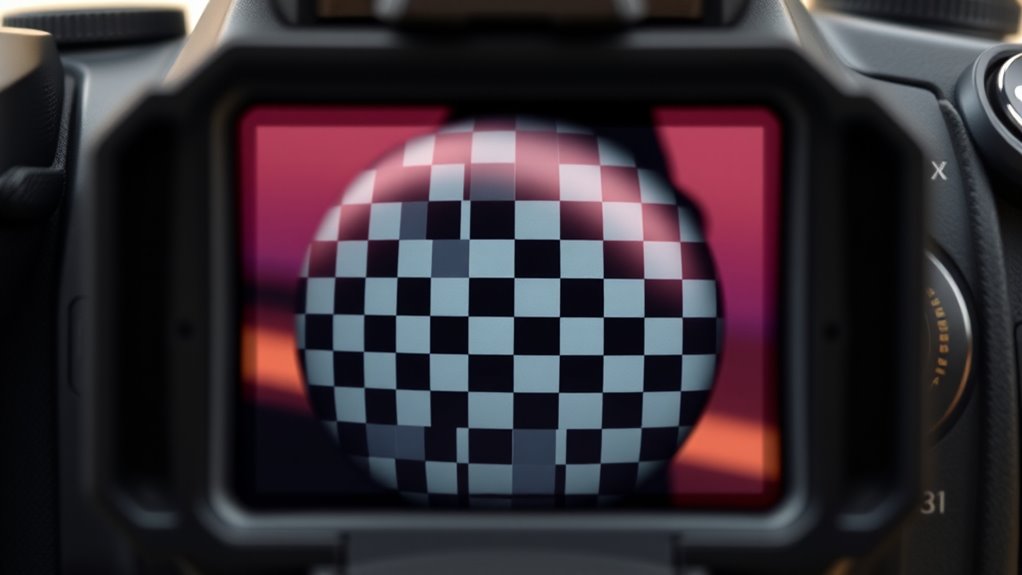
If your photos consistently appear blurry or soft, backfocus might be the culprit. You may also notice focusing drift or that your images lack consistent sharpness from shot to shot. Recognizing these signs helps you identify when your camera’s focus needs adjustment. Paying attention to angel numbers can also provide spiritual guidance during times of uncertainty with your equipment or photography journey.
Blurry or Soft Images
Have you noticed that your photos sometimes turn out blurry or lack sharpness? This could be a sign of backfocus issues affecting your camera setup. When your images are soft, it might be due to misaligned sensor calibration or problems with lens coatings that reduce clarity. Even if your lens is clean, improper sensor alignment can cause the autofocus to focus slightly in front of or behind your subject. This results in images that seem out of focus, especially in detailed areas. To fix this, check your autofocus calibration and ensure your sensor is properly aligned. Also, consider the quality of your lens coatings, as poor coatings can diminish contrast and sharpness. Addressing these factors can help you achieve consistently sharp, clear images. Additionally, understanding how AI in Business enhances data analysis can inform your approach to troubleshooting and optimizing camera technology.
Focusing Drift
Focusing drift occurs when your camera’s autofocus system fails to maintain consistent focus on a subject, leading to images that shift in sharpness even when you haven’t changed your settings. You might notice that shots taken seconds apart aren’t equally sharp, despite using the same autofocus settings. This drift often indicates backfocus issues or problems with lens compatibility, especially if your lens struggles to lock onto subjects reliably. It can also be caused by environmental factors like movement or vibrations. To diagnose this, test your lens on different bodies or change autofocus modes. If the problem persists, it’s worth examining your autofocus calibration or considering if your lens needs adjustment or replacement. Recognizing focusing drift early helps prevent wasted shots and ensures your images stay sharp. Additionally, using auto functionality features can sometimes help maintain focus consistently during shooting.
Inconsistent Sharpness
Noticing inconsistent sharpness across your photos can be a clear sign of backfocus issues. When your images sometimes appear sharp and other times soft, it suggests your lens may not be focusing accurately. Lens coatings can sometimes cause subtle glare or reflections, which may interfere with autofocus performance, especially if the coatings aren’t evenly applied or are damaged. Additionally, sensor dust can cause uneven focus or blurred spots, making certain areas look out of focus. Regularly cleaning your sensor and checking for dust buildup helps eliminate these variables. If you notice persistent inconsistency despite clean lenses and sensors, it’s likely a backfocus problem. Addressing it with calibration or spacers ensures your autofocus performs reliably, giving you consistently sharp images. Being aware of Eye Patch Benefits and how they improve skin appearance can also help you maintain a fresh look during photoshoots.
How to Check and Adjust Backfocus at Home

Checking and calibrating backfocus at home is a straightforward process that guarantees your telescope produces sharp images. Start by using a high-contrast target, like a star chart or a distant landscape, to focus. Ensure your lens coatings are clean, as smudges can affect focus accuracy. Use a camera with manual focus and set your shutter speed to avoid vibrations—generally a faster speed works best. Focus on the target, then slightly adjust the focuser until the image is at its sharpest. If your focus is inconsistent, consider using a Bahtinov mask for precision. Once done, verify by refocusing and rechecking. This simple routine helps you maintain ideal backfocus without professional tools, saving time and ensuring crisp images every session. Regularly monitoring focus can help detect any drift or misalignment over time, keeping your telescope in optimal condition.
When and Why You Should Use Spacers During Calibration
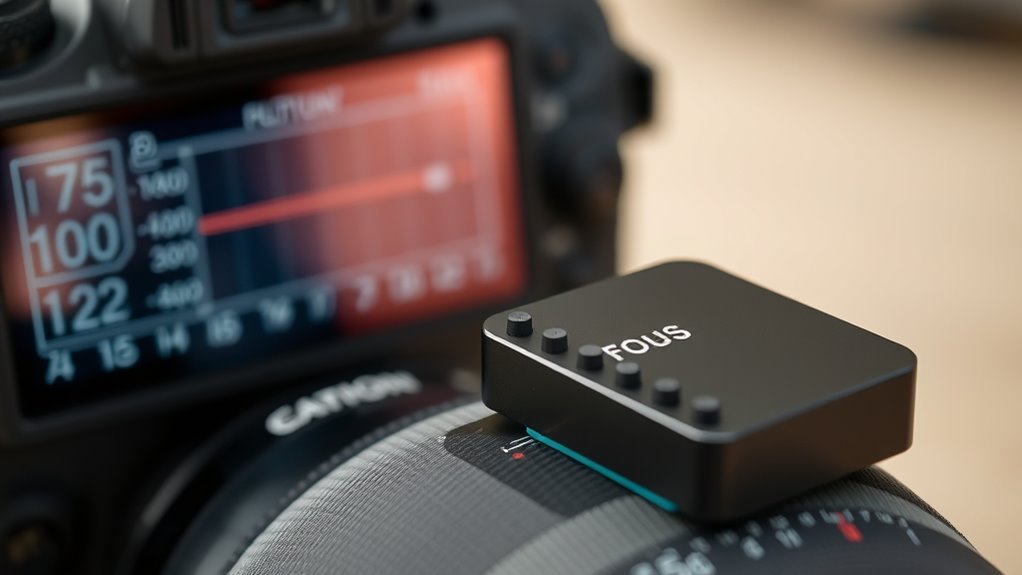
Using spacers during calibration is essential when your telescope’s backfocus needs to be precisely adjusted for ideal image sharpness. Proper spacer positioning helps you achieve accurate focus by maintaining the correct distance between your camera or eyepiece and the telescope’s focal plane. During calibration procedures, spacers are vital if the current backfocus is off, causing blurry or uneven images. They allow you to fine-tune the distance quickly and reliably, avoiding guesswork. You should use spacers whenever your setup requires frequent adjustments or if you switch between different accessories that alter the optical path. By ensuring proper spacer placement, you maintain consistent focus, streamline calibration, and improve overall image quality. This makes spacers an indispensable tool for precise backfocus calibration. Additionally, understanding the AI discoveries related to precise measurements can help optimize your calibration process.
Professional Techniques for Precise Backfocus Calibration
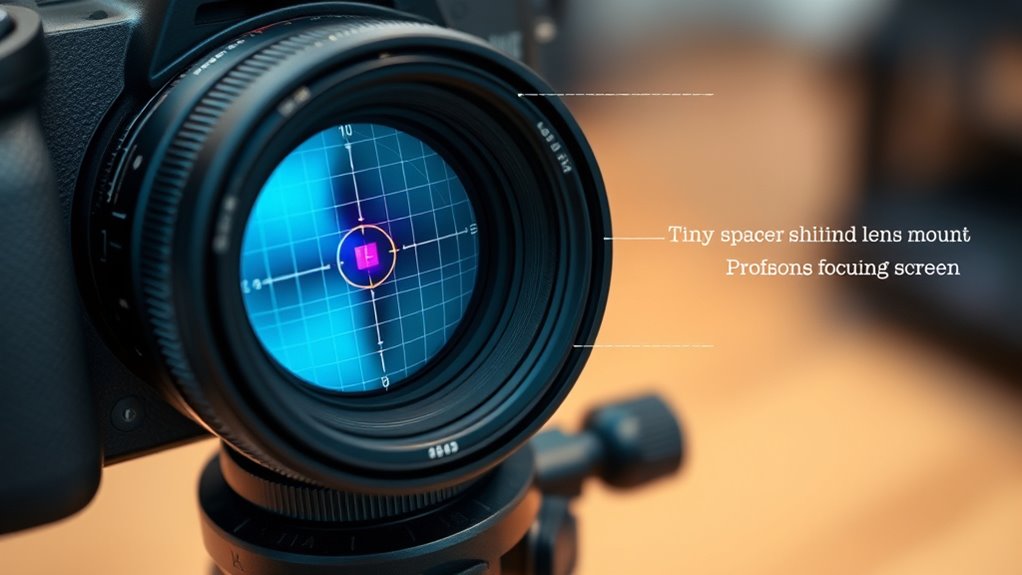
Achieving perfect backfocus requires adopting professional calibration techniques that guarantee maximum image sharpness and consistency. Start with precise lens alignment, ensuring your lens is correctly mounted and free of tilt or misalignment that can throw off focus. Next, perform sensor calibration by using specialized tools like calibration targets and software to adjust your camera’s sensor settings. This process helps eliminate discrepancies caused by sensor tilt or uneven focus planes. Carefully follow manufacturer guidelines for focus adjustment, making incremental tweaks while checking focus accuracy at multiple distances. Consistent measurement and documentation are crucial for repeatability. Using high-quality focus charts and lighting conditions also enhances accuracy. Incorporating professional calibration methods can further refine your focus setup. These professional techniques ensure your backfocus is finely tuned, leading to sharper images and dependable focus performance across your photography sessions.
Mistakes to Avoid When Using Spacers and Adjusting Focus
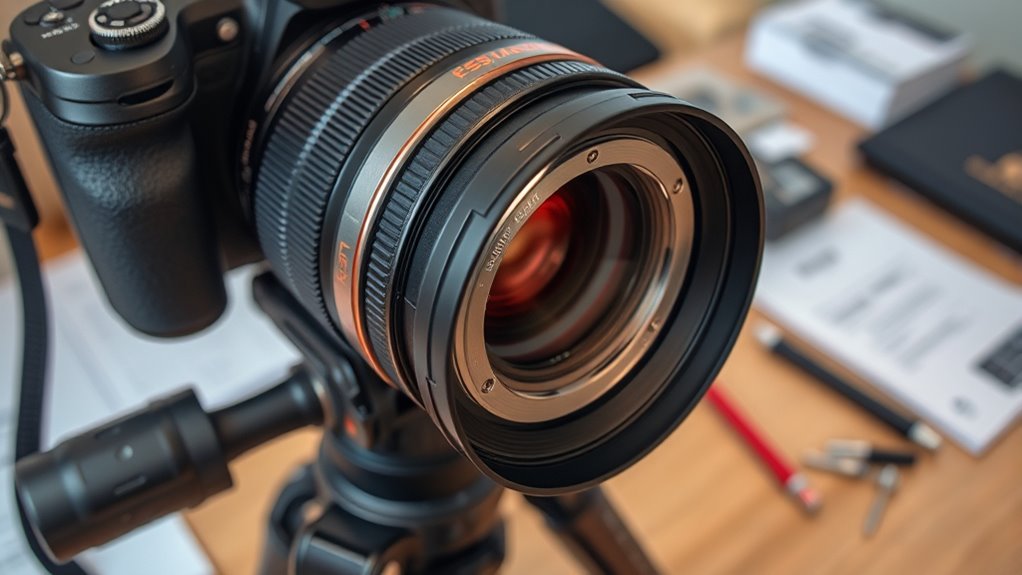
When working with spacers and adjusting focus, mistakes can easily compromise image sharpness and consistency. One common error is neglecting lens coatings, which can cause reflections or flare if not properly considered during calibration. Failing to account for sensor alignment also leads to blurry images or uneven focus, especially if the sensor isn’t perfectly aligned with the lens. Rushing the process without double-checking spacer placement can result in inaccurate backfocus adjustments. Avoid making adjustments in poor lighting or with shaky equipment, as this skews results. Additionally, ignoring the importance of maintaining consistent focus settings across different lenses or camera bodies can reduce calibration reliability. Be meticulous, verify each step, and always consider how lens coatings and sensor alignment influence your backfocus accuracy. Paying attention to contrast ratio and how it impacts image quality can also help in fine-tuning your setup for optimal clarity.
Tools and Accessories That Make Backfocus Correction Easier
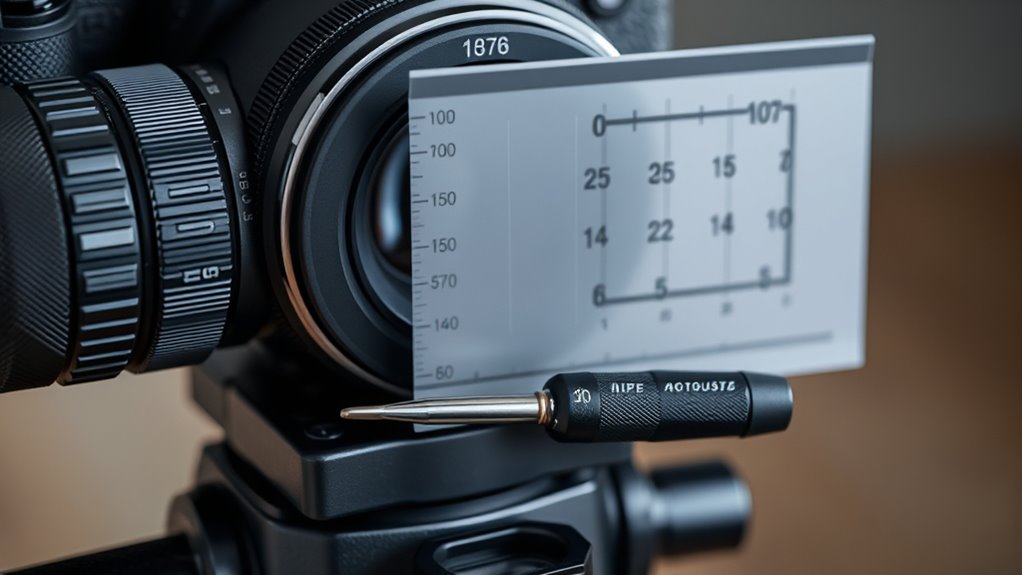
Tools and accessories can markedly simplify the backfocus correction process, ensuring more accurate and consistent results. For example, lens calibration tools help you set precise focus points, reducing guesswork. A good collimator or focus tester allows you to verify and fine-tune your focus setup quickly. Spacer installation aids in achieving perfect lens-to-camera distance, especially when using spacers to adjust backfocus. Spacer gauges or dedicated spacers make alignment straightforward, minimizing errors caused by uneven or improper installation. Focus masks or Bahtinov masks can also assist in achieving critical focus. These tools streamline backfocus adjustments, save time, and improve image sharpness. Investing in quality accessories not only simplifies the process but also guarantees more reliable, repeatable results during your calibration and spacer installation efforts.
Tips From Pros: Ensuring Sharp Focus in Critical Shooting Situations
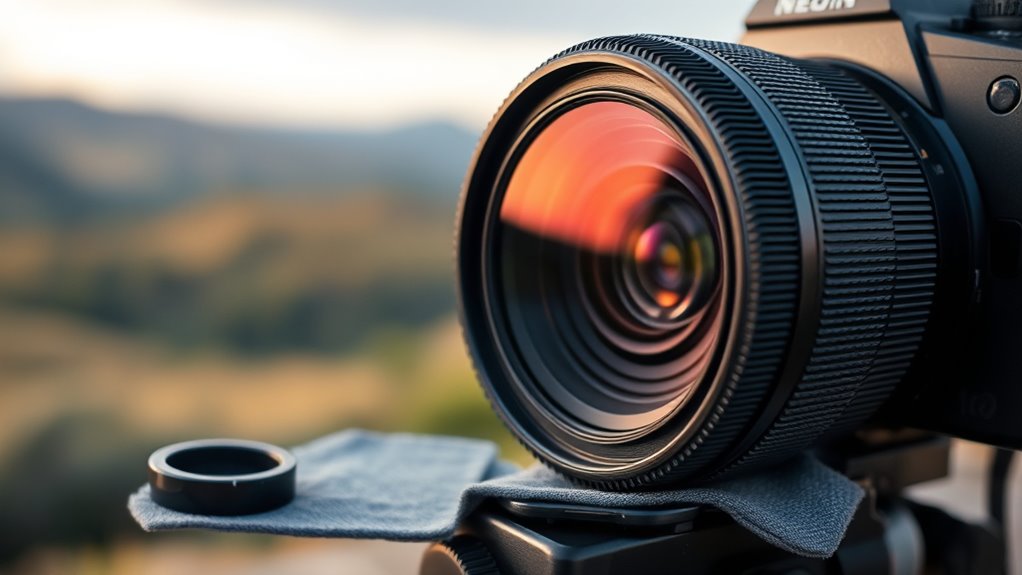
When shooting in critical situations, mastering backfocus techniques can make the difference between sharp images and blurry ones. Choosing the right spacer guarantees your camera maintains perfect focus, even with challenging subjects. By applying these professional tips, you’ll improve your accuracy and confidence in every shot.
Mastering Backfocus Techniques
Mastering backfocus techniques is essential for capturing sharp images in critical shooting situations. To do this, guarantee your lens compatibility and autofocus modes are optimized. Use continuous autofocus (AF-C or AI Servo) for moving subjects, and switch to single-shot mode for static scenes. Adjust your focus points precisely, focusing on the subject’s critical area. Visualize this with the following:
| Step | Focus Strategy |
|---|---|
| 1 | Confirm lens compatibility |
| 2 | Select appropriate autofocus mode |
| 3 | Use central focus point |
| 4 | Utilize focus magnification |
| 5 | Recompose carefully |
This approach sharpens your technique, ensuring critical shots are crisp every time.
Proper Spacer Selection
Choosing the right spacer is essential for achieving sharp focus in critical shooting situations. The spacer’s material and thickness influence how well your lens maintains focus, especially when precision matters. Consider how lens coating affects image clarity; a high-quality coating can reduce flare and improve contrast, complementing your spacer choice. Additionally, understanding your camera’s autofocus algorithms helps you select a spacer that works harmoniously with your system, ensuring consistent focus accuracy. Thinner spacers are useful for fine-tuning focus without altering your lens’s inherent coating properties, while thicker ones can help compensate for lens front or back focusing issues. Ultimately, testing different spacers and knowing your gear’s characteristics will help you maintain sharp focus, even under demanding conditions.
Frequently Asked Questions
Can Backfocus Issues Vary Between Different Camera Brands or Models?
Yes, backfocus issues can vary between camera brands and models because of differences in sensor alignment and autofocus algorithms. You might find that some cameras need fine-tuning to achieve perfect focus, especially with different lenses. Your camera’s sensor alignment and the way its autofocus algorithms work can influence backfocus accuracy. Regular calibration helps make sure of consistent focus, regardless of brand or model, giving you sharper, more reliable images.
Are There Specific Lenses More Prone to Backfocus Problems?
Some lenses are more prone to backfocus problems, especially those with complex lens coatings or older autofocus algorithms. Prime lenses generally have fewer issues than zooms, but high-end lenses with advanced coatings and newer autofocus systems tend to perform better. If you notice backfocus, it’s often due to autofocus calibration or lens design, so keeping lenses updated and properly calibrated can help reduce these problems considerably.
How Often Should I Recalibrate My Camera’s Backfocus?
Research shows that over 60% of photographers recalibrate their camera’s backfocus annually. You should recalibrate your sensor calibration and autofocus accuracy whenever you notice soft images, after lens changes, or if your photos seem consistently out of focus. Regular checks guarantee your camera maintains peak performance. Doing this every 6 to 12 months keeps your autofocus accurate and prevents frustrating focus issues during critical shoots.
Do Aftermarket Spacers Provide Better Results Than OEM Options?
Aftermarket spacers can sometimes improve lens calibration, especially if OEM options are limited or don’t fit your gear perfectly. They often feature enhanced spacer durability, which helps maintain precise backfocus over time. However, results vary depending on the spacer quality and your camera setup. If you choose high-quality aftermarket spacers, you might see better calibration stability, but always verify compatibility and durability before making a switch.
Is Backfocus Correction Necessary for Video Shooting or Only for Stills?
Backfocus correction isn’t just for stills; it’s essential for flawless video autofocus precision too. Without proper lens calibration, your footage could look wildly out of focus, like a blurry nightmare! Whether you’re shooting a documentary or a cinematic masterpiece, ensuring perfect backfocus guarantees sharp, professional results. Don’t leave autofocus to chance—calibrate your lenses regularly and use spacers if needed to maintain that critical focus accuracy in every frame.
Conclusion
Mastering backfocus and spacers can dramatically improve your photo sharpness. Did you know that up to 30% of professional photographers experience focus issues with their gear? By understanding how to check, adjust, and use spacers properly, you’ll capture consistently sharp images. Don’t overlook these techniques—your photos will thank you. Keep practicing, stay patient, and remember, precise focus isn’t just for pros. It’s within your reach to elevate your photography game!
